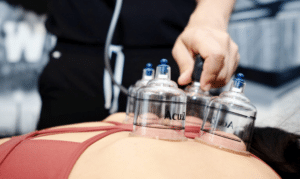
Cupping Therapy: A Modern Take on an Ancient Technique
Cupping therapy has been around for centuries in many cultures as a way to treat pain and other ailments. It is an ancient method of healing

Cupping therapy has been around for centuries in many cultures as a way to treat pain and other ailments. It is an ancient method of healing that uses suction cups on the skin to stimulate the body’s natural healing ability. It is a powerful treatment for many conditions, including headaches, muscle tension, and respiratory issues. Cupping therapy can also be used to help improve circulation, reduce inflammation, and promote relaxation.
Cupping therapy is a type of alternative medicine practice that has been used for thousands of years. It involves the use of glass or plastic cups which are heated and placed on the skin to create suction. This suction pulls at the underlying tissue, allowing increased circulation in that area and helping to relieve pain and inflammation. Cupping is believed to help stimulate the body’s natural healing processes, promote relaxation and wellness, and increase energy flow. It is often used in conjunction with other forms of massage or acupuncture to achieve the best results.
Cupping therapy has a range of potential benefits including improving circulation, reducing inflammation, relieving muscle tension, and relieving headaches. It can also be used to help release toxins from the body, improve digestion, and reduce stress. Cupping therapy is believed to help stimulate the lymphatic system, which helps the body remove waste more efficiently.
During a cupping therapy session, the practitioner will apply heated cups to various points on your body. The heat of the cup creates a vacuum-like suction that helps draw out toxins and improve circulation in the area being treated. Depending on your individual needs, the cups may be placed directly onto the skin or used in conjunction with massage techniques. It is important to communicate with your practitioner about any areas of discomfort.
Dry cupping is a form of cupping therapy that involves the use of suction cups on the skin without the use of oil or massage techniques. This type of treatment is often used to help reduce inflammation and muscle tension, as well as improve overall circulation.
Wet cupping is a form of cupping therapy that involves the use of massage oils or lotions on the skin prior to the application of suction cups. This type of treatment can be used to help draw out toxins from the body, reduce inflammation, and improve overall circulation.
Cupping therapy has been used for centuries in traditional Chinese medicine. But does it have any scientific basis? While there is limited research on cupping, some studies suggest that it may have therapeutic benefits.
One study found that cupping helped to reduce pain and improve function in patients with chronic neck pain. Another study showed that cupping was effective in treating lower back pain when combined with other therapies such as acupuncture.
There are also theories about how cupping works from a scientific perspective. One hypothesis is that the suction created by the cups increases blood flow and stimulates the immune system, leading to healing effects within the body.
However, more research is needed to fully understand how cupping works and its potential benefits. In addition, it’s important to note that like any medical treatment, cupping should be done under the guidance of a trained practitioner.
While there is some evidence supporting the use of cupping therapy for certain conditions, more research is needed before conclusions can be drawn about its effectiveness.
Cupping therapy is an ancient form of healing that has been used for centuries in many cultures. It is a powerful treatment for various conditions, including headaches, muscle tension, and respiratory issues. Cupping therapy can also be used to help improve circulation, reduce inflammation, and promote relaxation. There are two main types of cupping therapy – dry and wet – and each has its own set of benefits. It is important to communicate with your practitioner about any areas of discomfort during a session, as well as understand the difference between the two forms of treatment.
A1: Cupping therapy should not be painful, although you may feel a slight tugging sensation as the cups are applied. If you experience any pain during a session, please communicate this to your practitioner.
A2: The number of cupping therapy sessions you will need will depend on your individual needs and goals. It is best to discuss this with your practitioner prior to beginning treatment.
A3: After a cupping therapy session, it is recommended that you drink plenty of water and rest for the remainder of the day. This will help your body process and release any toxins that were drawn out during the session.

Cupping therapy has been around for centuries in many cultures as a way to treat pain and other ailments. It is an ancient method of healing
Call 323.939.9039 or click below to schedule an appointment.